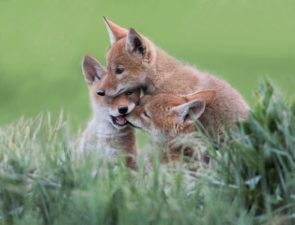 Introduction: Coyotes (canus latrans). Whether you love them or not, they command respect. Being canines, there is much about them that elicits feelings of familiarity and fondness for they are related to domestic dogs (canis familiaris). At the same time, we are struck by their raw wildness, which is no surprise for they are also related to wolves (canis lupus). In fact, they can interbreed with both (coydogs, wolfcoys).
Introduction: Coyotes (canus latrans). Whether you love them or not, they command respect. Being canines, there is much about them that elicits feelings of familiarity and fondness for they are related to domestic dogs (canis familiaris). At the same time, we are struck by their raw wildness, which is no surprise for they are also related to wolves (canis lupus). In fact, they can interbreed with both (coydogs, wolfcoys).
In the American West, coyotes are considered vermin because of predatory attacks on livestock. Increasingly, in towns and cities across the nation, they are resented because they have adapted to live near people and may prey upon domestic pets. Truly wild predators in human habits are not a good fit.
When we view them in nature, however, we recognize them as a part of the web of life, a part that maintains the health of every ecosystem. They are a natural reality, and that makes them fascinating, beautiful, dreadful for their prey, and important for their natural role as predators. I’d hate to think of how overrun we’d be with rodents if we did not have coyotes in the mix of wildlife.
During my recent stay at Malheur National Wildlife Refuge, Terry joined me for a couple of days. While I was driving a truck along the narrow, graveled Central Patrol Road that stretches the 42-mile length of the refuge, his eagle-eyes spotted twitching coyote ears in tall grass. The pup was just across the Blitzen River from us and not more than 50 feet away. The setting sun shined directly into our eyes, making photographing the little tyke very difficult. With no time to setup on a beanbag window-platform, Terry handheld his camera and quickly got off just a few shots before the pup disappeared into the berm that bordered the river beneath.
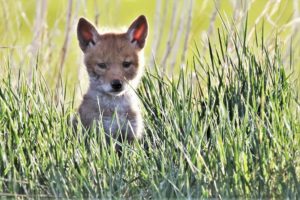
Given the pup’s very young age, and with no adult coyote in sight, he suspected we had happened upon a youngster venturing out from the den, so a plan began to unfold for the coming days.
Two evenings later, after Terry had returned home to Grant County, I returned to the coyote den an hour before sunset to prepare for the possibility of a repeat appearance of the coyote. As usual, I drove up, shut off the engine, concealed myself behind the big lens/camera opening of my window, didn’t (never do) get out, and remained totally still and silent. About an hour later, I was wondering if the long drive was worth it. Then the sun hit the horizon and two sets of ears appeared above the grass line. “Thank you!” This shoot did not last long, but it was long enough to capture a favorite image from nearly two weeks of visiting the pups from this den.
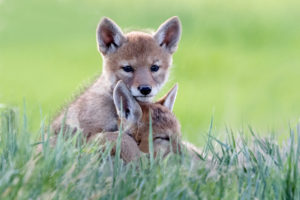
Day three at the coyote den didn’t produce pups, but certainly added to the story. I was late to arrive because other photo subjects along the route demanded my attention. As I slowly crept up to the den area, I spotted Mama Coyote trotting along the top of the opposite river bank about a hundred feet from the den site. She was brushed up behind willows and as she spotted me, she did an abrupt 180 degree turn and started skulking back to the den.
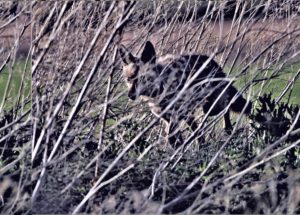
When she was just beyond it by a few yards, she stopped and came right out into the open before me. It was an obvious ploy to get me focused on her. With no pups in sight, she stood before me and then trotted off up the river, expecting I would follow her. I remained motionless, without showing my face and waited in place. No pups that night. Somehow, she must have signaled to them to remain in the den. It was very interesting to note that for all the rumbling and tumbling of the litter mates, they made almost no vocal sounds near the den. Is that survival behavior hard-wired in them or taught by Mama, I wonder?
A week had passed since Terry discovered the coyote den; and this time not one, not two but three pups appeared on schedule just as the sun set below the ridge to the west.
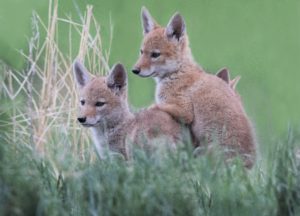
They seemed preoccupied, focused on something adjacent to them but out of my sight. They were also very aware of my presence, acting curious – not fearful. However, they were situated in a bit of a depression on the berm and I didn’t have a clear shot of them for most of the shoot. Nevertheless, during about a half an hour’s shooting, they offered some darn cute poses.
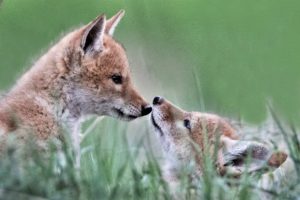
The coyote den shoots became increasingly engaging. Meaning, I began to feel that there was some level of acceptance of my presence – even though I tried hard to never show my profile, my face or make any eye contact. I believe most wildlife do not interpret an inanimate object like a vehicle (noiseless) as a threat. I had visited several times at that point, with no threatening consequences to them. They were aware of me, but knew I was not about to enter their comfort zone. The following visit confirmed this in a way I never expected. Once more, I was delayed and missed an early-in-place (6:30 p.m.) arrival. Other shooting opportunities developed that I couldn’t pass up. As I rolled to a stop near the den at 7:30 p.m., I spotted Mama Coyote and her young ones heading west into the meadow. They saw me, but didn’t sprint away – just kept moving along, as if hunting for field mice, voles, gophers or ground squirrels. It seemed like she was turning the litter in a slight arc back towards the river. I decided to position myself like always, across from the den, in case they returned before it was too dark to photograph them. It wasn’t long before the first pup popped up on top of the berm at the den site.
I was surprised when Mama Coyote made an abrupt entrance out front, right across from my window. The following moment was amusing, an experience I’ll recall often and enjoy forever. She looked hard at me. She looked at her pups playing above the den in the open. She closed her eyes as if going inside her head to think things over. Again, she looked at me, looked at the pups, looked up river, at me again, turned and trotted away.
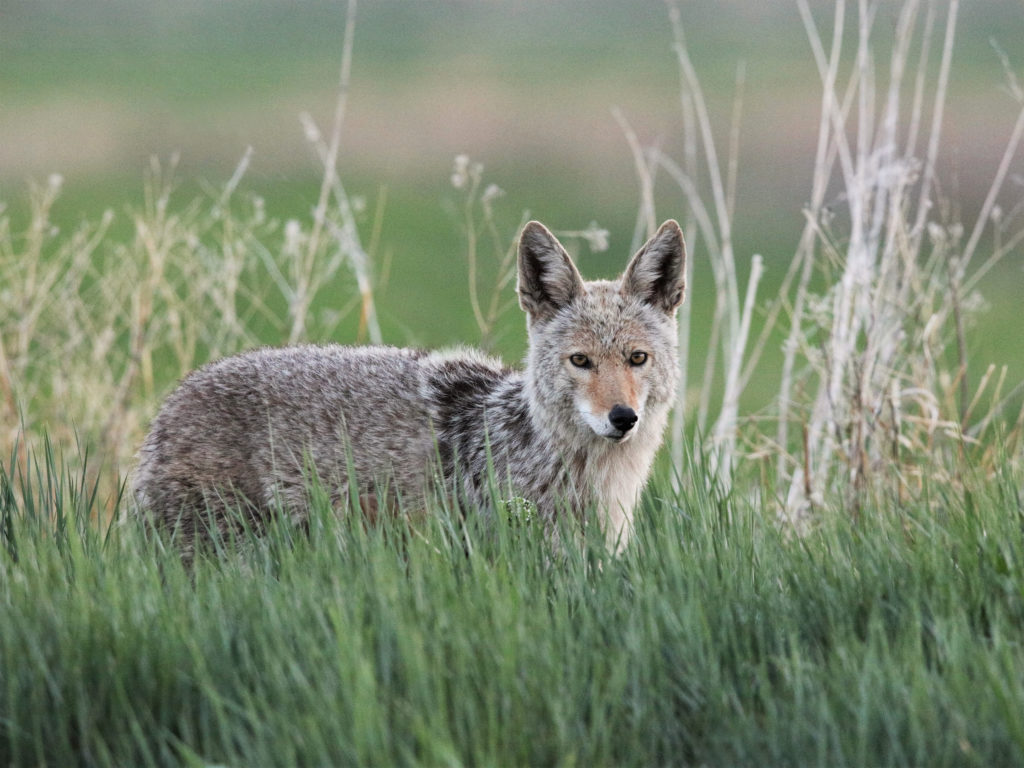
That’s when the fun began – the pups were in my charge and ready for action. Click-click, click-click… giggle, snort, laugh, click, click, click. You can see what I mean…
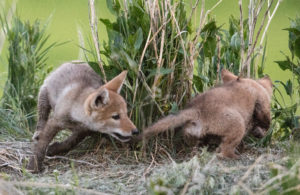
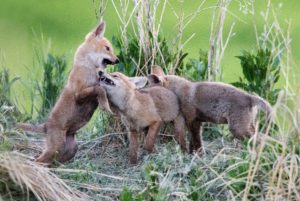
Morning light from behind me should have offered much better shooting conditions, although I didn’t know if the pups would be present at that time of day. I had not been able to get away in the a.m. until May 17th – 11 days since our discovery of the den. There had been rain in the area, and the sky was still quite dark. What I didn’t anticipate is that the frolicking pups would be rolling in the mud as they chased one another in circles. All their guard hairs were wadded into wet clumps. It was a special kind of mud wrestling!
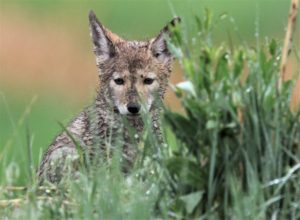
My time for photography on the Central Patrol Road was running out. I made one last trip to the coyote den on a Saturday morning with the hope of finding the pups on a dry sunlit day. I was not disappointed. By then, I knew their routine, and they knew mine. There were many levels of satisfaction and pleasure photographing the coyotes throughout that time. The photography was special, but in many ways, it was simply the means to experience deep nature, profoundly wild nature, in an intimate way. It can only be characterized as real joy.
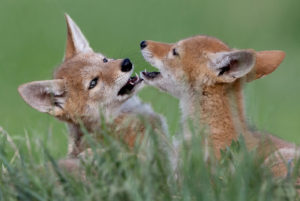
The images of this blog and many more photos of the pups can be viewed full screen in this slideshow: https://terrysteelenaturephotography.com/the-coyote-den-malheur-national-wildlife-refuge-may-2018/